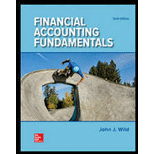
1.
Compute inventory turnover for each company for the most recent years shown.
1.
Explanation of Solution
Inventory turnover:
This is the ratio which analyzes the number of times inventory is sold during the period. This ratio gauges the efficacy of inventory management. Larger the ratio, more efficient the inventory management.
Calculate inventory ratio for Company A’s current year as follows:
Calculate inventory ratio for Company A’s one year prior as follows:
Calculate inventory turnover ratio for Company M’s current year as follows:
Calculate inventory turnover ratio for Company M’s one year prior as follows:
2.
Compute days’ sales inventory for each company for three years shown.
2.
Explanation of Solution
Days’ sales Inventory:
Days’ sales in inventory are used to determine number of days a particular company takes to make sales of the inventory available with them.
Calculate days’ sales inventory for the Company A’s current year as follows:
Calculate days’ sales inventory for the company A’s one year prior as follows:
Calculate days’ sales inventory for the Company A’s two year prior as follows:
Calculate days’ sales inventory for the Company M’s current year as follows:
Calculate days’ sales inventory for the Company M’s one year prior as follows:
Calculate days’ sales inventory for the Company M’s two year prior as follows:
3.
Comment and interpret your findings from parts 1 and 2. Assume an industry average for inventory turnover of 15.
3.
Explanation of Solution
Interpret and Comment:
- Company A’s inventory turnover ratio is more efficient than Company M.
- Company A’s days’ sales inventory is fewer than company M.
- Company A’s inventory turnover ratio is more than the industry average of 15 for inventory turnover for both the current year and prior year, but Company M is slightly below the industry average in both the current year and prior years.
- Company M’s days’ sales inventory seems a bit too high comparing with the Company A.
Want to see more full solutions like this?
Chapter 5 Solutions
FINANCIAL ACCT.FUND(LL)W/ACCESS>CUSTOM<
- What is independence of the audit?arrow_forwardBruno Manufacturing uses direct labor-hours in its predetermined overhead rate. At the beginning of the year, the total estimated manufacturing overhead was $680,000. At the end of the year, actual direct labor-hours for the year were 42,500 hours, manufacturing overhead for the year was underapplied by $25,500, and the actual manufacturing overhead was $695,000. The predetermined overhead rate for the year must have been closest to: A) $16.00 B) $15.75 C) $16.35 D) $16.94arrow_forwardWhat was manufactured overhead?arrow_forward
- Which of the following choices is the correct status of manufacturing overhead at year-end?arrow_forwardMorris Corporation applies manufacturing overhead at the rate of $40 per machine hour. Budgeted machine hours for the current period were anticipated to be 200,000; however, higher than expected production resulted in actual machine hours worked of 225,000. Budgeted and actual manufacturing overhead figures for the year were $8,000,000 and $8,750,000, respectively. On the basis of this information, the company's year-end overhead was: A. overapplied by $250,000 B. underapplied by $250,000 C. overapplied by $750,000 D. underapplied by $750,000arrow_forwardAt the beginning of the year, manufacturing overhead for the year was estimated to be $560,000. At the end of the year, actual labor hours for the year were 35,000 hours, the actual manufacturing overhead for the year was $590,000, and the manufacturing overhead for the year was underapplied by $30,000. If the predetermined overhead rate is based on direct labor hours, then the estimated labor hours at the beginning of the year used in the predetermined overhead rate must have been ___ hours.arrow_forward

 AccountingAccountingISBN:9781337272094Author:WARREN, Carl S., Reeve, James M., Duchac, Jonathan E.Publisher:Cengage Learning,
AccountingAccountingISBN:9781337272094Author:WARREN, Carl S., Reeve, James M., Duchac, Jonathan E.Publisher:Cengage Learning, Accounting Information SystemsAccountingISBN:9781337619202Author:Hall, James A.Publisher:Cengage Learning,
Accounting Information SystemsAccountingISBN:9781337619202Author:Hall, James A.Publisher:Cengage Learning, Horngren's Cost Accounting: A Managerial Emphasis...AccountingISBN:9780134475585Author:Srikant M. Datar, Madhav V. RajanPublisher:PEARSON
Horngren's Cost Accounting: A Managerial Emphasis...AccountingISBN:9780134475585Author:Srikant M. Datar, Madhav V. RajanPublisher:PEARSON Intermediate AccountingAccountingISBN:9781259722660Author:J. David Spiceland, Mark W. Nelson, Wayne M ThomasPublisher:McGraw-Hill Education
Intermediate AccountingAccountingISBN:9781259722660Author:J. David Spiceland, Mark W. Nelson, Wayne M ThomasPublisher:McGraw-Hill Education Financial and Managerial AccountingAccountingISBN:9781259726705Author:John J Wild, Ken W. Shaw, Barbara Chiappetta Fundamental Accounting PrinciplesPublisher:McGraw-Hill Education
Financial and Managerial AccountingAccountingISBN:9781259726705Author:John J Wild, Ken W. Shaw, Barbara Chiappetta Fundamental Accounting PrinciplesPublisher:McGraw-Hill Education





